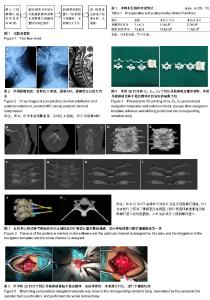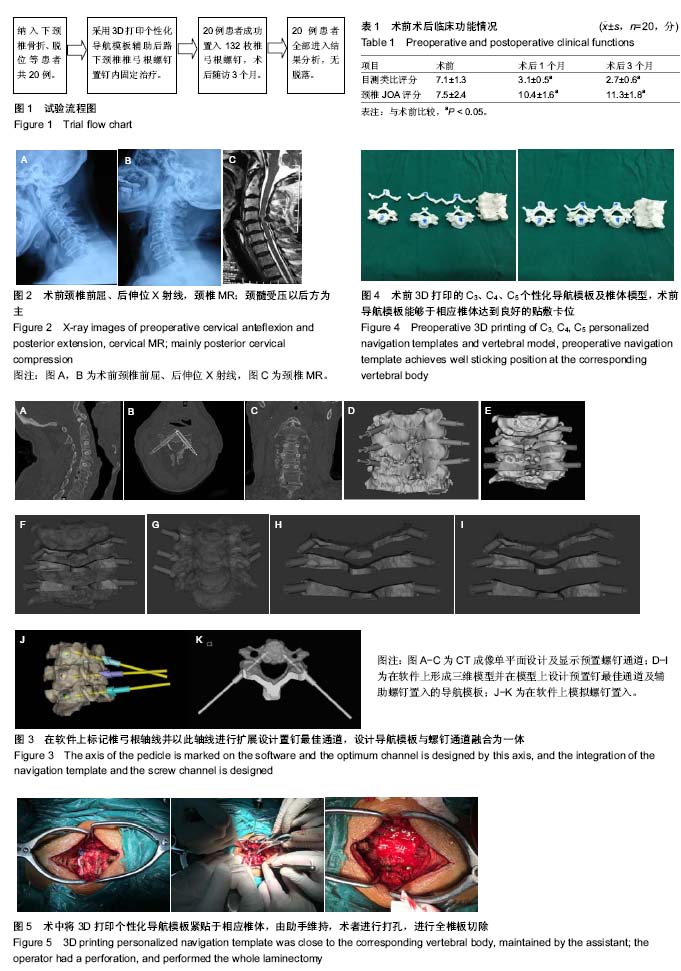| [1] Abumi K, Itoh H, Taneichi H, et al. Transpedicular screw fixation for traumatic lesions of the middle and lower cervical spine: description of the techniques and preliminary report. J Spinal Disord. 1994;7(1):19-28.[2] Kotani Y, Cunningham BW, Abumi K, et al. Biomechannical analysis of cervical stabilization systems: an assessment of transpedicular screw fixation in the cervical spine. Spine. 1994;19(22):2529-2539.[3] 贾卫斗,贾薇薇,杨飞,等. 颈椎椎弓根个体化固定技术治疗261例颈椎疾患临床观察[J]. 海南医学院学报,2010,16(1):78-83.[4] 贾卫斗,杨飞,贾薇薇,等. 颈椎椎弓根内固定治疗下颈椎伤病193例个体化设计及临床应用[J]. 河北医科大学学报,2010, 31(9):1065-1069.[5] Ludwig SC, Kramer DL, Balderston RA, et al. Placement of pedicle screws in the human cadaveric cervical spine: comparative accuracy of three techniques. Spine.2000; 25: 1655-1667.[6] 赖必华,吴建斌,叶宏,等. 导向器结合钉道内壁探查法在下颈椎椎弓根螺钉置入中应用研究[J]. 中国骨伤, 2017, 30(9): 805-809.[7] Cao J, He F, He L, et al. Experimental study on screw insertion in lower cervical pedicle assisted by multi-spiral computerized tomography three dimensional reconstruction techniques. Zhongguo Xiufu ChongjianWaike Zazhi. 2010; 24(5): 525-530.[8] Hwang TJ, Kiang C, Paul M. Surgical applications of 3-dimensional printing and precision medicine. JAMA Otolarygngol Head Neck Surg. 2015;141(4): 305-306.[9] Tack P, Victor J, Gemmel P, et al. 3D-printing techniques in a medical setting: a systematic literature review. Biomed Eng Online. 2016;15(1):115. [10] 严广斌. 视觉模拟评分法[J]. 中华关节外科杂志(电子版),2014, 8(2):273.[11] 姜良海,谭明生,杨峰,等. 标杆型3D打印导板辅助颈椎椎弓根置钉的临床应用[J].中华骨科杂志, 2016, 36(5): 257-264.[12] Kawaguchi Y, Nakano M, Yasuda T, et al. Development of anew technique for pedicle screw and Magerl screw insertionusing a 3-dimensional image guide. Spine(Phila Pa 1976). 2012;37(23): 1983-1988.[13] 黄轩,李凤宁,张帆,等.个体化三维打印导航模板辅助下颈椎椎弓根置钉的实验研究[J].中国矫形外科杂志,2014,22(20): 1880-1884.[14] 胡宗,杨广忠.下颈椎椎弓根螺钉固定的相关研究进展[J].兵团医学,2011,27(1):37-40.[15] Chanplakorn P, Kraiwattanapong C, Aroonjarattham K, et al. Morphometric evaluation of subaxial cervical spine using multi-detector computerized tomography (MD-CT) scan: the consideration for cervical pedicle screws fixation. Bmc Musculoskeletal Disorders. 2014; 15(1):1-10.[16] Karaikovic EE, Yingsakmol W, Gaines RW Jr. Accuracy of cervical pedicle screw placement using the funnel technique. Spine. 2001;22:2456-2462.[17] 张洪磊,周东生,王大伟. 导航辅助置入下颈椎椎弓根螺钉的误差分析[J]. 中国矫形外科杂志,2009,17(4):260-263.[18] Rajasekaran S, Avadhani A, Shetty AP. Axial translaminar screw placement using three-dimensional fluoroscopy-based navigation. Singapore Med J. 2011;52:15-18.[19] Giesel FL, Hart AR, Hahn HK, et al. 3D reconstructions of the cerebral ventricles and volume quantification in children with brain malformations. Acad Radiol. 2009;16(5):610-617.[20] Guarino J, Tennyson S, Mc Cain G, et al. Rapid prototyping technol-ogy for surgeries of the pediatric spine and pelvis: benefits analysis. J Pediatr Orthop. 2007;27(8) : 955-960.[21] 王远政,田晓滨,刘洋,等. Mimics及颈椎模型用于下颈椎椎弓根个体化置钉的应用研究[J]. 第三军医大学学报,2012,34(15): 1543-1547.[22] 徐双,王清,钟德君,等. 钉道设计在颈椎椎弓根固定中的应用[J]. 中国矫形外科杂志,2011,19(12):1043-1045.[23] Gelalis ID, Paschos NK, Pakos EE, et al. Accuracy of pedicle screw placement: a systematic review of prospective in vivo studies comparing free hand, fluoroscopy guidance and navigation technique. Eur Spine J. 2012;21(2):247-255.[24] 陈国平,陆声,徐永清,等. 数字化导航模板在下颈椎椎弓根定位定向中的应用[J]. 西南国防医药, 2010, 20(6):596-598.[25] 谭海涛,谢兆林,江建中,等. 数字化导航模板在颈椎椎弓根螺钉置入中的应用[J].中国脊柱脊髓杂志, 2015, 25(6):497-502.[26] Liu YJ,Tian W,Liu B,et al. Comparison of the clinical accuracy of cervical ( C2-C7) pedicle screw insertion assisted by fluoroscopy, computed tomography-based navigation,and intraoperative three-dimensional C-arm navigation. Chin Med J (Engl). 2010;123(21): 2995-2998. [27] 张昊,胡亚威,刘阳,等.颈椎弓根置钉植入的新型3D打印导板有效性研究[J]. 中国临床解剖学杂志,2017,35(2):147-150.[28] 王庆德,梅伟,张振辉,等.个体化导航模板辅助颈椎椎弓根螺钉置入与徒手螺钉置入的准确性比较[J]. 山东医药,2017, 57(16): 5-7.[29] 宁金沛,吴卫东,覃求,等. 3D打印个体化导航模板在胸椎和颈椎椎弓根螺钉植入的临床应用[J].实用骨科杂志,2015, 21(5): 385-389.[30] Bozkus FI, Ames CP, Chamberlain RH, et al. Biomechanical analysis of rigid stabilization techniques for three column injury in the lower cervical spine. Spine. 2005;8:915-922.[31] 朱彦昭,徐荣明,吴建民.下颈椎椎弓根螺钉内固定的研究进展[J].中医正骨,2010,22(8):62-65.[32] 陈国平,陆声,徐永清,等. 数字化导航模板在下颈椎椎弓根定位定向中的应用[J]. 西南国防医药,2010,20(6):596-598+698.[33] 王飞,刘志斌,张建华,等. 3D打印导航模板在辅助寰枢椎椎弓根螺钉置入中的应用价值[J]. 中国脊柱脊髓杂志,2017,27(1): 61-68.[34] Van Dijk M, Smit TH, Jiya TU, et al. Polyurethane real-size models used in planning complex spinal surgery. Spine. 2001;26(17):1920-1926.[35] 宋柯,付茂庆,孔祥雪,等.生物安全性的下颈椎后路经椎弓根固定的个性化导航模板研究[J]. 中国临床解剖学杂志, 2012, 30(5): 509-512.[36] 黄轩,李凤宁,张帆,等.个体化三维打印导航模板辅助下颈椎椎弓根置钉的实验研究[J]. 中国矫形外科杂志, 2014, 22(20): 1880-1884.[37] 白宇哲,李长树,徐楚,等. 数控机床技术在下颈椎个体化导向模板制作中的应用[J].中国临床解剖学杂志,2015, 33(3):284-287. |



